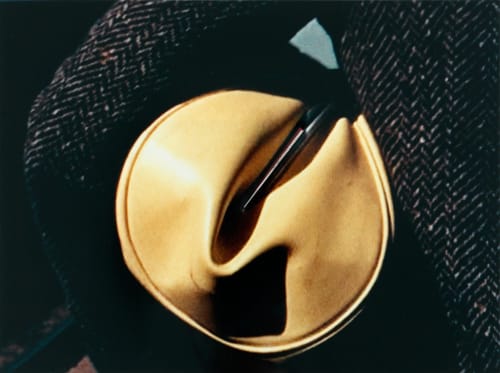Martina Sauter (B. 1974, Germany) extracts images from music videos and iconic Hollywood films to create photographic collages that teeter between fiction and reality. Sitting in front of her television screen, she scans for scened charged with fimic suspence.
Alfred Hitchock said that there is a distinct cinematic difference between surprise and suspense, teaching us that the terror is not in the bang itself, but rather in the anticipation leading up to it. “I believe in putting the horror in the minds of the audience, and not necessarily on the screen”, he proclaimed. It’s exactly that lingering Hitchcockian suspense that German artist Martina Sauter distils into her photographic collages.
Playing upon our collective memory of cinema and popular culture, her images feature visual citations from moving image scenes. While some come from recognisable sources such as Hitchcock’s films, or frames from David Bowie’s music videos, others are taken from more obscure references, such as cult Chinese sci-fi cinema. “I choose films with a special attention to daily life, and recently I’ve been looking at particularly psychological themes”, she explains. Any narrative that plays out within domestic space is potential raw material. Sitting in front of her television screen, Sauter plays a film and watches closely, scanning for images with a certain filmic tension to extract. “I hold the camera up in front of the screen and wait”, she explains, “freezing the images I want and shooting pictures of them while static”.
The fact that we may recognise the images we see adds to the experience. Conditioned by our knowledge of pre-existing narratives and an uneasy sense of Déjà vu, Sauter wants the stories we think we recall when we look at her images to mingle with the ones we project upon on them. “When I choose a film still it’s my idea that it should be familiar, and that you should recognise it’s taken from a film, but you can’t quite place which one, so your mind starts searching for stories”.
Sauter achieves this by carefully choosing scenes. Though the protagonists of her images are often iconic figures from Hollywood such as Grace Kelly and James Stewart, it is often hard to tell at first. Her technique is often to include just a part of their body or a face obscured from view, if the character even appears at all. “The scenes I choose are often in between two actions – a person just left the room, or is just about to enter it. In these pregnant moments, the viewer can imagine a possible before or after and project this upon the space”.
Combining these isolated film stills with ones she has staged and taken herself, Sauter puts a particular emphasis on interior spaces. “My practice started with an interest in how interiors can hold the traces of a personality of a fictional character without us having to see them”, she tells us. This interest developed into re-imagining the scenes that fictional characters appear in. “I don´t try to restage the interior of the film. Instead I construct alternate interiors that could have been there and photograph them, creating new spaces for the characters based on what I know about them.”
The latest chapter in Sauter’s body of work has taken a turn towards the abstract, as the artist considers the process of creating collages, and the way she cuts into them. Instead of shifting images over one another as one normally would to create a collage, she has begun to make incisions into the photographic material she collects and slide the fragments into pieces of photographic paper. Still using film stills as her reference, the artist has become preoccupied with the suggestion of a ‘behind’ or an ‘inside’ of an image, and the ways she can tease that suggestion out, like the inner workings and underlying narratives of a film.

